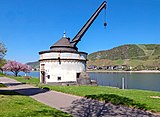Basal icebreaker
A basal icebreaker is a building protection against drift ice made of basalt stones that has been known since the Middle Ages . It represents a porch in pyramid or prism shape made of massive basalt blocks, fixed to structures near the river . The stone material had to be harder than the driving ice in order to fulfill its purpose. The blocks were usually secured to one another with iron clamps to provide a bond and were always attached to the main attack area on the upstream side from which the danger threatened. With its hard and sharp front edge, it splits any floating ice floes and thus diverts the main pressure of the ice from the building, thereby protecting it from destruction or damage. Unprotected buildings were torn away from the ice during heavy ice drift, as the millennium floods in the winter of 1783/84 in Cologne and especially in Mülheim am Rhein and Neuss showed. A few buildings with this facility have survived the times. The old Krahnen in Andernach from the 16th century built such a basal icebreaker up the Rhine as a special feature, which saved the crane house from safe destruction in 1784 and also protected it from earlier and later ice drifts. Since 1661, the entire city of Andernach was protected by the cannon-equipped bulwark in the northeast of the city wall with an acute-angled entrenchment to the Rhine, which also served as an icebreaker, as the city was located in a bend in the Rhine and was therefore in great danger of drifting ice. This bulwark was previously used as a defensive bastion close to the shore, today it is a memorial for war victims. The Alte Kranen in Marktbreit am Main, built in 1784, was also given this protection, as its predecessor, a half-timbered construction , fell victim to the ice drift that winter of 1784 without this protection.
Basalt bridge piers that are particularly prone to drift ice, such as the Balduin Bridge over the Moselle in Koblenz or the wooden bridge from Bad Säckingen over the Upper Rhine , were also built in a corresponding acute-angled shape in order to use the integrated icebreaker to break up the floating ice floes and thus protect the structure.

